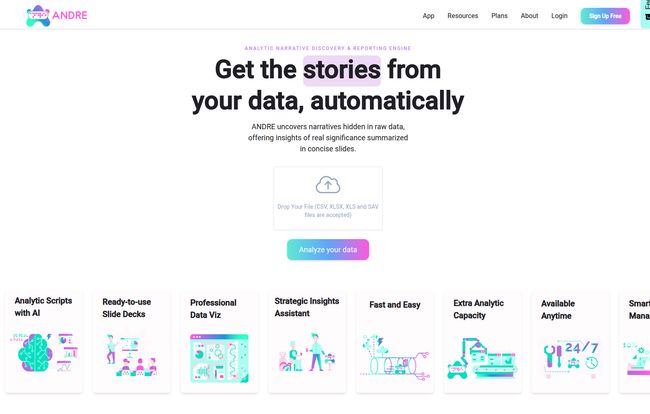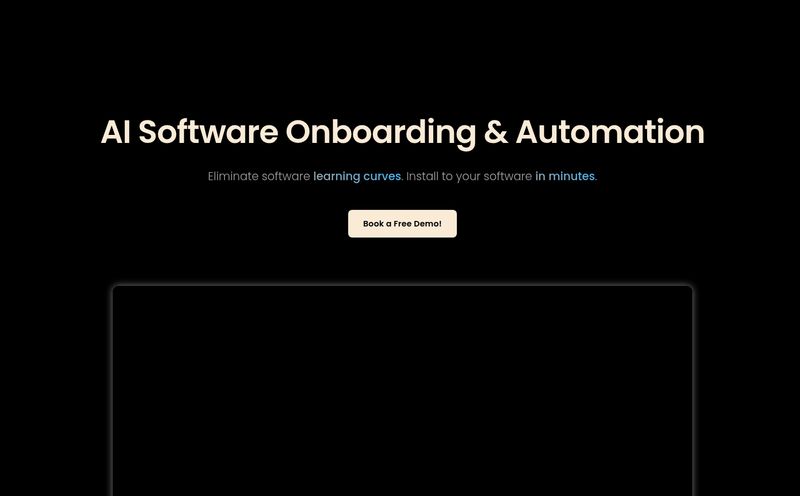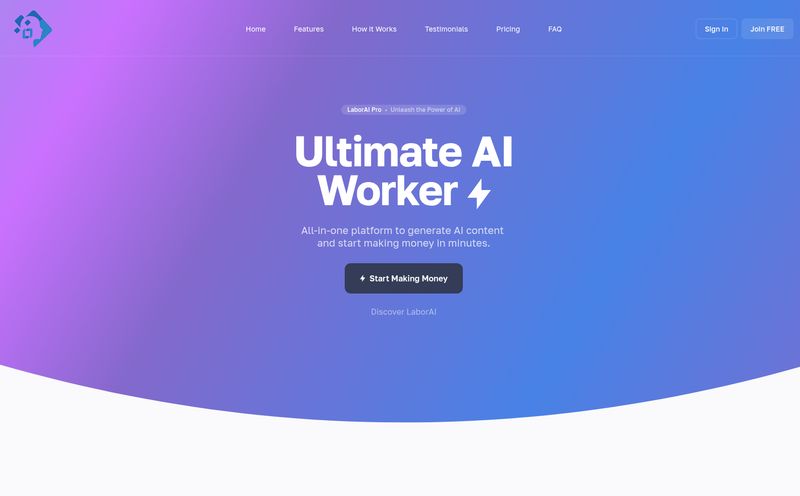If you've ever run a survey of any decent size, you know the feeling. The responses pour in, you close the survey, and you’re hit with a wave of… dread. Pure, unadulterated, spreadsheet-induced dread. You’re staring at a massive CSV file, thousands of rows of opinions and ratings, and your job is to somehow turn that digital sludge into a coherent story. A story that your boss, or your client, will actually understand.
For years, this has been my reality. A painful tango with Excel pivot tables, trying to cross-tabulate demographics with satisfaction scores, and then spending hours, sometimes days, forcing it all into a PowerPoint deck that still feels… flat. It’s a grind. A necessary one, but a grind nonetheless.
So when I first heard about a tool called ANDRE.ai, which claims to automate this entire process using AI, my professional skepticism flared up. We've all seen the “AI-powered” label slapped onto everything these days. But this one promised to be different. It wasn't about just crunching numbers; it was about finding the narrative. I had to give it a shot.
So, What Exactly is ANDRE.ai?
Think of ANDRE not as a calculator, but as a translator. It’s designed to take your raw, messy survey data and translate it into a human-readable story. It’s an AI platform that automates the most tedious parts of survey data analysis. You feed it your data, and it spits out a full-blown report, complete with data visualizations, key takeaways, and what it calls “synthesis slides.”
This isn't just about making charts prettier. It's about the AI digging through the data to find the connections you might miss. It looks for the “why” behind the “what.” Instead of just showing you a bar chart that says “72% of users are satisfied,” it aims to build a slide that might say, “User satisfaction is highest among females aged 25-34, who primarily use our mobile app and value customer support above all other features.” Now that's an insight you can actually use.
It feels less like a traditional stats package like SPSS and more like having a junior data analyst on call 24/7. An analyst who doesn't need coffee and never complains about reworking the slides for the third time.
The Familiar Pain ANDRE Aims to Heal
I remember one project a few years back. We’d just completed a massive customer feedback survey with over 5,000 responses and dozens of questions. My job was to present the findings to the leadership team. I spent the better part of a week buried in spreadsheets, my eyes glazing over. I built so many pivot tables that I think I sprained a finger. By the time I was done, I was so deep in the weeds that I could barely see the forest for the trees.
That’s the core problem ANDRE is trying to fix. It’s for the market researchers, the product managers, the UX folks, and the marketing strategists who are brilliant at their jobs but aren't necessarily trained statisticians. We know our customers, but we get bogged down by the mechanics of data wrangling. ANDRE promises to handle the grunt work, freeing you up to do what you do best: think strategically about the insights.
Getting Your Data into the Machine is Surprisingly Easy
My first pleasant surprise was the data import process. A tool like this is useless if you can't get your data into it easily. Thankfully, ANDRE plays nice with pretty much everyone in the survey sandbox. You can connect it directly to your accounts on:
- Typeform
- Survey Monkey
- Qualtrics XM
And if you’re old school (like me, a lot of the time), you can just upload a file. It handles all the usual suspects: CSV, XLSX (Excel), and even .SAV files from SPSS. That SPSS compatibility is a nice touch, a little nod to the serious researchers out there. Connecting my Google Drive was also a cinch. This flexibility is a huge win, removing one of the biggest initial barriers to trying a new tool.

Visit ANDRE
The Magic Moment: From Raw Data to a Coherent Story
This is the part that matters. I uploaded a sample dataset from a past client survey – a few hundred responses, a mix of multiple-choice and rating scales. I hit the “Analyze” button and… waited. It wasn't instant, which is good. It felt like something was actually happening, not just a canned response.
A few minutes later, I had a link to a full-blown report. And I’ve gotta say, I was impressed. It wasn’t just a jumble of charts. It was a structured slide deck. It started with an executive summary, then broke down the demographics, and then went into key themes it had identified. The charts were clean and clear, but the real power was in the text synthesis on each slide. It pulled out the most important finding and wrote a sentence or two explaining it. It had already done the first, most painful 80% of the work for me.
It even found a few interesting cross-tabulations I hadn't thought to look for. It was that “Aha!” moment that usually takes hours of manual digging. Of course, it’s not perfect. The AI is a powerful assistant, not a replacement for a human brain. You still need to review the story it tells, maybe tweak the narrative, and add your own layer of strategic context. But the heavy lifting? Done.
A Look at the Pricing: What’s the Catch?
Alright, so it’s cool. But what does it cost? The pricing structure is actually pretty straightforward, and I appreciate that they have a genuinely useful free tier.
| Plan | Price | Who It's For |
|---|---|---|
| Hobbyist | $0 / month | Students, individuals with a single project, or anyone who just wants to kick the tires. It's generous enough to get a real feel for the platform. The main catch is you have to include their attribution on your reports. |
| Pro | $15 / month | Freelancers, marketers, or researchers who handle a few projects a month. You get more datasets and reports, plus you can customize the design theme to match your own branding. Attribution is still required, though. |
| All Access | $50 / month | This is the plan for power users, agencies, and corporate teams. Unlimited everything, no attribution, and the killer feature: downloading your report as a PPTX file. That alone is worth the price of admission if you live in a world of client presentations. |
My Take on the Tiers
The Hobbyist plan is fantastic. It’s not a crippled trial; you can genuinely analyze a project from start to finish. For a student or a quick internal project, it’s perfect.
The Pro plan at $15 is a very reasonable step up for professionals who need a bit more volume and want to apply their own branding. But, that required attribution could be a sticking point for some client work. You'd have to check your contracts.
For me, and I suspect for most people working in agencies or larger companies, the All Access plan is the one that makes the most sense. The ability to download a fully editable PowerPoint deck is the feature that integrates ANDRE into a real-world professional workflow. You let the AI do the first draft, then you download it and add your final polish and strategic commentary in a format everyone knows and uses.
The Good, The Bad, and The Honest Truth
No tool is perfect, right? After playing around with it for a while, here’s my honest breakdown.
What I genuinely liked: The time-saving is astronomical. I'd estimate it cuts down the initial data-wrangling and reporting phase by, no exaggeration, 80-90%. It makes sophisticated analysis accessible to people who aren’t data scientists, and I love that democratization of data. The focus on narrative is the real differentiator. It’s a subtle but powerful shift from just showing data to explaining it.
What could be better: The limitations on the lower-tier plans are understandable, it's a business after all, but still a factor. Having the PPTX download locked away in the most expensive tier is a classic SaaS move, but one that I wish wasn't there. Also, while it's great at quantitative and structured data, it's not really designed to do deep thematic analysis of open-ended qualitative responses. You'd still need another process for that.
My Final Verdict: Is ANDRE.ai a Must-Have?
So, is it time to delete your Excel shortcuts and throw your SPSS manuals in the bin? Not quite. But ANDRE.ai has carved out a seriously impressive niche for itself.
If you are a market researcher, product manager, UX researcher, or marketer who regularly deals with survey data and finds yourself bogged down in the reporting process, then yes. I think ANDRE.ai is a phenomenal investment. It’s an efficiency tool that pays for itself after just one or two projects in the hours you get back. The All Access plan, in a professional context, is a small price to pay to essentially have an AI research assistant on your team.
It’s not here to replace human insight. It's here to augment it. It clears away the debris so you can see the gold underneath. And for anyone who has ever stared at a spreadsheet with a thousand-yard stare, that’s a pretty magical thing.
Frequently Asked Questions (FAQ)
- 1. How does ANDRE.ai handle data privacy and security?
- This is a big one for any cloud-based tool. According to their site, they take security seriously. However, as with any platform, you should always review their specific privacy policy and terms of service, especially if you are uploading sensitive customer or client data.
- 2. How is ANDRE different from just using ChatGPT to analyze data?
- While you can paste small amounts of data into a tool like ChatGPT, ANDRE.ai is a purpose-built platform. It's specifically designed for structured survey data, has direct integrations with survey tools, and is optimized for creating visual reports and slide decks. It's the difference between a Swiss Army knife and a scalpel.
- 3. Can I customize the reports and visualizations?
- On the Pro and All Access plans, you can customize the design theme (colors, logos) to match your brand. For full customization of every single element, the best workflow is to use the All Access plan to download the PPTX file and then edit it directly in PowerPoint or Google Slides.
- 4. Does it work with open-ended text responses?
- ANDRE's primary strength is in analyzing structured, quantitative data (e.g., multiple choice, scales, ratings). While you can upload data with text responses, it's not a qualitative analysis tool for thematic coding or sentiment analysis of long-form text. It’s best used for the quantitative parts of your survey.
- 5. Is the free 'Hobbyist' plan actually useful?
- Absolutely. It's not a time-limited trial. You can use it for a complete, albeit smaller, project. It's perfect for seeing if the tool's output and workflow fit your needs before committing to a paid plan.



